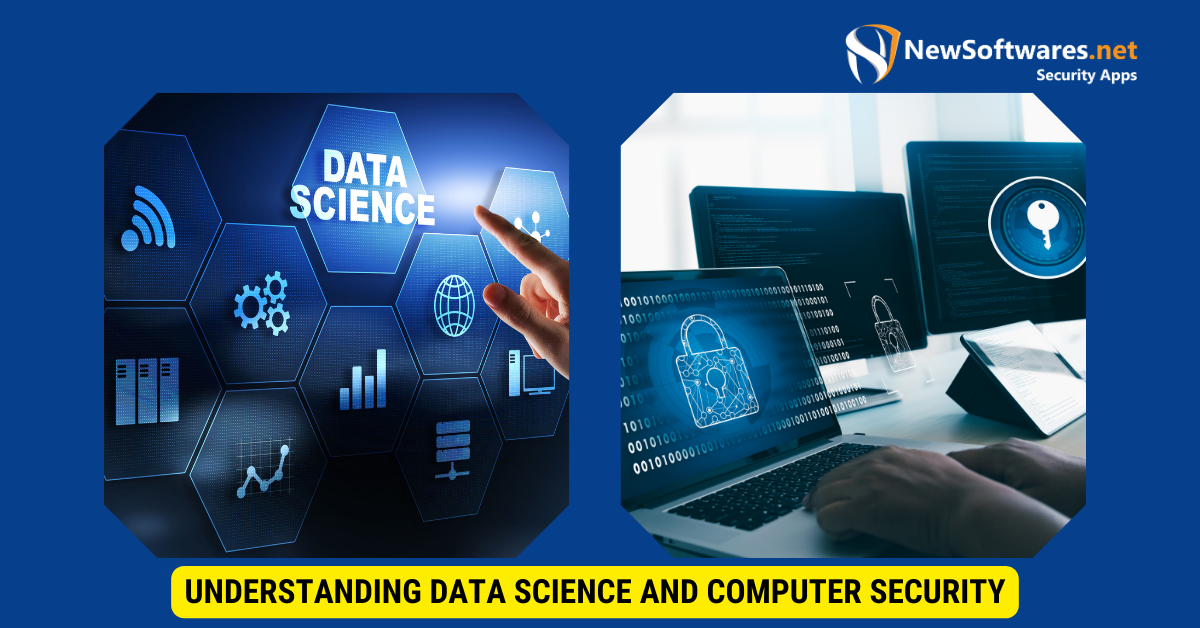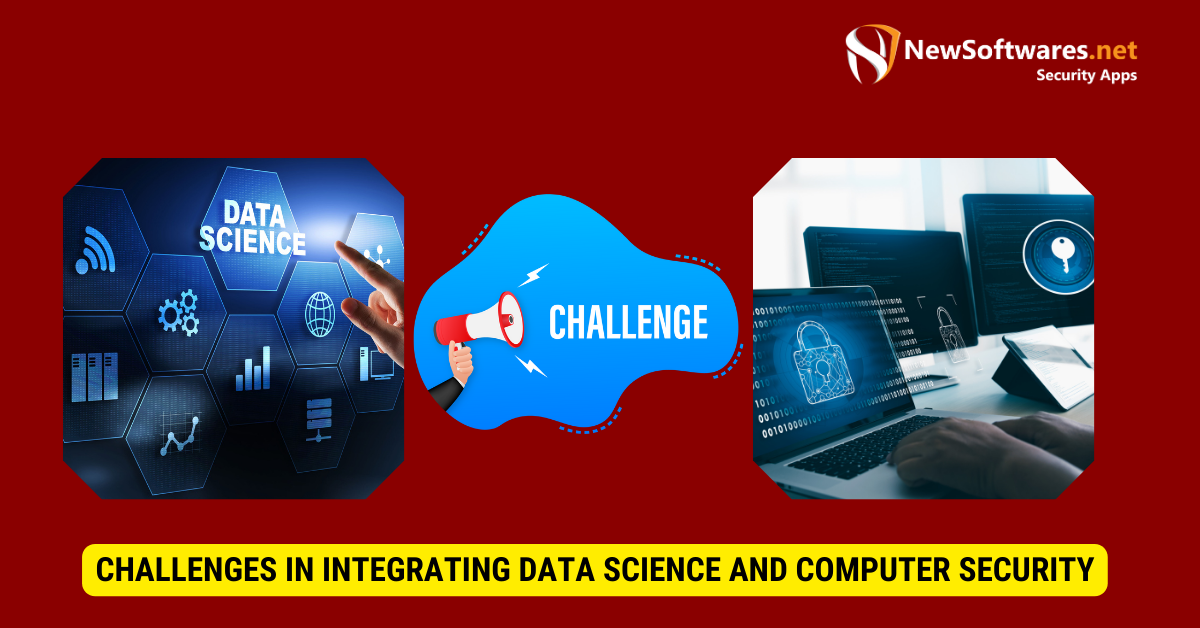Data science and computer security intersect in areas like threat detection, anomaly detection, and predictive analytics to enhance security measures
Data science and computer security have increasingly intertwined in today’s digital world. Both play crucial roles in protecting and managing the vast data generated daily. Understanding the relationship between these two disciplines is essential for ensuring a secure and efficient technological landscape.
Understanding Data Science and Computer Security

The first step in comprehending the connection between data science and computer security is to define each discipline individually.
Defining Data Science
Data science involves extracting meaningful insights and knowledge from complex and often unstructured data sets. Data scientists discover patterns, trends, and correlations by applying scientific methods, statistical analysis, and machine-learning techniques to make informed decisions and predictions.
Data science is a multidisciplinary field that combines elements of mathematics, statistics, computer science, and domain expertise. It encompasses various stages of the data lifecycle, including data collection, cleaning, exploration, modeling, and interpretation.
One of the key challenges in data science is dealing with big data, which refers to extremely large and compound data sets that cannot be easily managed or analyzed using traditional methods. Data scientists use advanced tools and technologies, such as distributed computing frameworks and cloud platforms, to process and analyze big data efficiently.
Furthermore, data science is not limited to a specific industry or domain. It has applications in many fields, including healthcare, finance, marketing, social media, and transportation. Data scientists are crucial in serving administrations, making data-driven decisions, optimizing processes, and gaining a competitive edge.
Exploring Computer Security
On the other hand, computer security focuses on safeguarding the integrity, confidentiality, and availability of computer systems, networks, and data. It includes implementing security measures to prevent unauthorized access, protect against malicious attacks, and ensure data privacy.
Computer security is constantly evolving due to the ever-increasing sophistication of cyber threats. It encompasses various aspects like network, application, information, and physical security.
Network security protects computer networks from unauthorized access, data breaches, and attacks. It includes firewalls, intrusion detection systems, and virtual private networks (VPNs) to secure network communications.
Application security focuses on identifying and mitigating vulnerabilities in software applications to prevent unauthorized access, data leaks, and code exploits. It involves techniques like secure coding practices, penetration testing, and vulnerability scanning.
Information security protects sensitive data from unauthorized disclosure, alteration, or destruction. It involves implementing access controls, encryption, and data backup strategies to ensure data confidentiality and integrity.
Physical security protects physical assets like servers, data centers, and computer equipment. It includes surveillance systems, access controls, and disaster recovery plans to safeguard against physical threats and natural disasters.
Computer security professionals, also known as ethical hackers or cybersecurity experts, play a critical role in identifying vulnerabilities, detecting and responding to security incidents, and implementing security best practices to mitigate risks.
The Intersection of Data Science and Computer Security
Integrating data science principles and techniques into computer security practices has become increasingly vital in lecturing the complex challenges of the digital age.
As technology advances, the volume and difficulty of data generated have grown exponentially. This explosion of data has created new opportunities for organizations to gain visions and make informed decisions. However, it has also opened the door to various cyber threats and attacks.
Role of Data Science in Computer Security

Data science plays a critical role in refining computer security measures. Through data analysis and modeling, organizations can identify and detect abnormal behavior patterns, enabling the early detection of potential cyber threats and attacks.
By leveraging machine learning algorithms, data scientists can grow predictive models that can identify potential vulnerabilities in a system. These models can examine vast amounts of data, including network traffic, user behavior, and system logs, to identify patterns that indicate a potential security breach.
Additionally, data science aids in the creation of robust intrusion detection systems and the development of effective algorithms for threat intelligence, allowing security professionals to stay one step ahead of attackers. By continuously analyzing and monitoring network traffic, data scientists can identify and respond to emerging threats in real time, minimizing the impact of potential attacks.
Moreover, data science techniques, such as anomaly detection and clustering, can help security professionals classify and categorize threats. This categorization allows organizations to prioritize their response efforts and allocate resources effectively.
How Computer Security Influences Data Science
Computer security is equally crucial for data science. Without robust security measures, valuable and sensitive data could be compromised, leading to severe consequences such as breaches and privacy violations.
Data scientists rely heavily on data availability and integrity to perform accurate analyses and generate reliable insights. If the data they work with is compromised or tampered with, it can lead to skewed results and erroneous conclusions.
By ensuring data integrity, confidentiality, and availability, computer security provides a solid foundation for data scientists to rely on when conducting analyses and making data-driven decisions. Robust security actions, such as encryption and access controls, protect sensitive data from unauthorized access, ensuring that data scientists can work with reliable and trustworthy information.
Furthermore, computer security practices, such as secure data storage and backup mechanisms, ensure data availability. Data scientists heavily rely on access to historical data for training machine knowledge models and conducting longitudinal studies. Data loss or corruption can significantly hinder their work without proper security measures.
In conclusion, the intersection of data science and computer security is symbiotic. Data science enhances computer security by enabling the early detection and prevention of cyber threats. In contrast, computer security provides a solid foundation for data scientists to work with reliable and trustworthy data. As technology evolves, the collaboration between these two fields will become increasingly important in safeguarding organizations’ digital assets and maintaining data integrity.
The Importance of Data Science in Cybersecurity
Cybersecurity, an essential aspect of computer security, heavily relies on data science methodologies and tools to detect and prevent threats effectively.
With the increasing complexity and rate of cyber attacks, organizations constantly seek innovative ways to protect sensitive information. This is where data science comes into play, offering powerful techniques and tools to combat these threats.
Predictive Analysis and Threat Detection
Data science enables the identification of patterns and trends in vast amounts of data, helping security professionals detect potential threats and anticipate cyber attacks before they occur. By leveraging machine learning algorithms, data scientists can analyze historical data and generate proactive insights, allowing real-time threat detection and prevention.
For example, by analyzing network traffic data, data scientists can develop models to identify abnormal patterns or behaviors, indicating a potential cyber attack. These models can then trigger automated responses, such as blocking suspicious IP addresses or alerting security teams, to mitigate the influence of the attack.
Data Encryption and Protection
Data encryption is fundamental to ensuring sensitive information remains hidden and unintelligible to unauthorized individuals. Through data science techniques, organizations can develop encryption algorithms and protocols that are nearly impossible to break, thereby safeguarding data from potential breaches.
Data scientists work closely with cybersecurity experts to design and implement robust encryption mechanisms. They analyze the vulnerabilities of existing encryption algorithms and develop new ones resistant to advanced hacking techniques. Data scientists play a crucial role in remaining one step ahead of cybercriminals by constantly evolving encryption methods.
Moreover, data science is also used to enhance data protection measures beyond encryption. Organizations can identify potential insider threats or unauthorized access attempts by analyzing data access patterns and user behavior. This allows them to implement additional security measures, such as multi-factor authentication or access controls, to prevent data breaches.
Data-driven Incident Response
Organizations must respond swiftly and effectively to minimize the impact of a cyber-attack. Data science is vital in incident response by providing actionable insights and automating certain response actions.
Data scientists can identify the scope and severity of an attack by analyzing real-time data from various sources, such as network logs, system logs, and user activity logs. This information helps security teams prioritize their response efforts and allocate resources accordingly.
Data science techniques, such as anomaly detection and clustering, can also assist in identifying the root cause of an attack. By understanding how the attack was executed and what vulnerabilities were exploited, organizations can take proactive measures to patch those vulnerabilities and prevent similar attacks in the future.
In addition, data science enables the automation of certain incident response actions. For example, when a known malware signature is detected, automated systems can isolate the affected system, block communication with malicious domains, and initiate recovery.
In conclusion, data science plays a critical role in cybersecurity by providing the means to detect, prevent, and respond to cyber threats effectively. By leveraging progressive analytics and machine learning techniques, administrations can stay ahead of cybercriminals and protect their valuable data and systems.
Challenges in Integrating Data Science and Computer Security

While the convergence of data science and computer security offers numerous benefits, several trials must be addressed to capitalize on their potential fully.
Data Privacy Concerns
Data science relies heavily on analyzing large datasets, so privacy concerns arise when dealing with personal and sensitive information. Striking a balance between data utilization for security purposes and protecting individuals’ privacy rights is a critical challenge that organizations must navigate.
Technical Challenges and Solutions
Integrating data science into computer security practices presents technical challenges, including scalability, performance, and interoperability. Developing scalable algorithms, efficient data processing frameworks, and standardized protocols is key to overcoming these hurdles.
Future Trends in Data Science and Computer Security
Data science and computer security are poised to undergo significant advancements fueled by emerging technologies.
The Rise of AI and Machine Learning
Artificial intelligence (AI) and machine learning (ML) are revolutionizing data science and computer security. AI-powered algorithms can analyze vast data, identify abnormal patterns, and provide automated responses to threats. ML models can continuously learn from new data, enabling security systems to adapt and evolve in real time.
The Impact of Quantum Computing on Security
Quantum computing, with its potential for exponentially faster calculations, poses opportunities and threats to data science and computer security. While quantum computing can enhance data analysis and encryption methods, it also has the potential to break currently secure algorithms. Researchers are actively exploring post-quantum encryption techniques to ensure data remains protected in the face of this emerging technology.
Key Takeaways
- Data science algorithms can analyze vast datasets to detect security threats.
- Anomaly detection helps in identifying unusual patterns that may signify breaches.
- Predictive analytics can forecast potential future threats based on historical data.
- Data science aids in visualizing security data for better insights.
- Both fields prioritize data integrity and confidentiality.
FAQs
Q: How does anomaly detection work in security?
A: Anomaly detection analyzes normal behavior patterns and flags deviations, which might indicate malicious activities.
Q: Can data science predict future cyber attacks?
A: Through predictive analytics, it can forecast potential threats based on past data but cannot predict specific future attacks with certainty.
Q: Is machine learning used in cybersecurity?
A: Machine learning is employed to enhance threat detection and response capabilities.
Q: How does data science help in security visualization?
A: Data science tools can transform complex security data into visual formats, making it easier to understand and analyze.
Q: Do security experts need to know data science?
A: While not mandatory, data science knowledge can greatly enhance a security expert’s capabilities.
Conclusion
In conclusion, data science and computer security are deeply interconnected fields that rely on each other to achieve robust and effective outcomes. Integrating data science principles into computer security practices enhances threat detection and enables proactive cybersecurity measures. Similarly, computer security provides the foundation for data scientists to access and analyze valuable data while ensuring its protection and privacy. We can better understand and appreciate the crucial relationship between data science and computer security by exploring these fields’ challenges and future trends.
